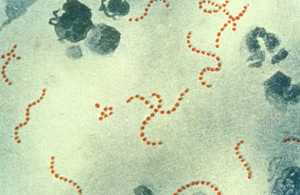PHE publish guidance for managing the continuing increase in scarlet fever cases
PHE reports 1,049 new cases of scarlet fever across England.

Public Health England (PHE) has reported a continued substantial increase in scarlet fever notifications across England with 1,049 new cases reported from 31 March to 6 April. A total of 7,198 new cases have now been reported since the season began in September 2013. Scarlet fever is a seasonal disease and this is the time of year when the highest numbers of cases are typically seen. As such, a decline in numbers of cases should become evident over the coming weeks.
PHE has this week published new guidance on the public health management of scarlet fever outbreaks in schools, nurseries and other child care settings. The guidance will support Health Protection Teams, working closely with schools, nurseries and colleagues in local authorities, to control outbreaks of scarlet fever in child care settings and protect vulnerable children and adults.
Dr Vanessa Saliba, PHE Consultant Epidemiologist, said:
The guidance has been developed in response to the current high levels of scarlet fever to assist local health protection teams in controlling the spread of infection in schools and nurseries when an outbreak is identified. The guidelines are based on a rapid review of the evidence and expert advice and will be kept under review as new evidence emerges.
The guidelines also include resources such as template letters for parents / guardians, staff and GPs highlighting the signs and symptoms of scarlet fever and the need for symptomatic children to stay off school and see their GP promptly. If a diagnosis of scarlet fever is made, antibiotics should be given and the child must stay off school until they have received 24 hours of antibiotics.
PHE strongly urge schools to embed good hand hygiene practices within daily routines for pupils and staff. Children and adults should be encouraged to cover their mouth and nose with a tissue when they cough and sneeze and to wash their hands after using or disposing of tissues.
Dr Theresa Lamagni, PHE’s head of streptococcal infection surveillance, said:
As scarlet fever cases continue to increase, PHE is working closely with healthcare professionals to assess the impact on the frequency of complications. We have a system in place to obtain a sample of strains from across the country to assess whether a new strain may have emerged.
While we hope that the Easter school break will assist in breaking the chains of transmission in schools, reducing numbers of cases, we cannot assume or rely on this being the case. As such, our investigations and assessment of the impact of this extraordinary rise in scarlet fever continue.
Scarlet fever is mainly a childhood disease and is most common between the ages of 2 and 8 years. It was once a very dangerous infection but has now much less serious although complications can arise, particularly in those who remain untreated. There is currently no vaccine for scarlet fever.
Notes to editors
- An average of 1,836 cases of scarlet fever, have been reported for the same period (September to April) in the previous 10 years (range 964 to 3,214).
- Regional breakdowns for scarlet fever seasonal activity in England: cases from weeks 37 in 2013 to weeks 15 in 2014.
| PHE Centre Name | Cases from Sept to April |
|---|---|
| Anglia and Essex | 319 |
| Avon, Gloucestershire and Wiltshire | 557 |
| Cheshire and Merseyside | 340 |
| Cumbria and Lancashire | 307 |
| Devon, Cornwall and Somerset | 239 |
| East Midlands | 1181 |
| Greater Manchester | 318 |
| Kent, Surrey and Sussex | 478 |
| London | 685 |
| North East | 464 |
| South Midlands and Hertfordshire | 380 |
| Thames Valley | 404 |
| Wessex | 341 |
| West Midlands | 530 |
| Yorkshire and the Humber | 655 |
| England | 7198 |
- View the latest health protection report.
- Guidance on the public health management of scarlet fever outbreaks in schools, nurseries and other childcare settings is available.
- Symptoms of scarlet fever include a sore throat, headache and fever accompanied by a characteristic rash. Although scarlet fever is usually a mild illness it should be treated with antibiotics to reduce risk of further complications.
- More information on hand hygiene available on the e-Bug website.
- Patient information is available from NHS Choices and PHE’s Frequently Asked Questions.
- Information for health professionals is available on the PHE website.
- Public Health England’s mission is to protect and improve the nation’s health and to address inequalities through working with national and local government, the NHS, industry and the voluntary and community sector. PHE is an operationally autonomous executive agency of the Department of Health. www.gov.uk/phe Follow us on Twitter @PHE_uk
UKHSA press office: National Infection Service
UKHSA press office, infectious diseases
61 Colindale Avenue
London
NW9 5EQ